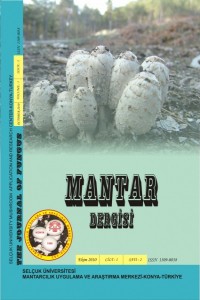Abstract
Bu çalışmada, Selimiye camii kütüphanesinde bulunan 15., 16., ve 17.yy dan kalma el yazması eserlerde karşılaşılan mikrobiyoloji kökenli bozulmalara neden olan mikrofungusların tespiti; aylık, mevsimsel ve meteorolojik faktörlerle ilişkisi ve alınacak önlemler araştırılmıştır. Mikrofungus izolasyonu için toplam 140 petri plağı kullanılmış ve bu plaklarda 322’si iç ortamdan, 114’ü dış ortamdan ve 1350’si eserlerden olmak üzere toplam 1786 mikrofungus kolonisi sayılmıştır. Çalışma sonucunda 18 mikrofungus cinsi (Acremonium, Alternaria, Aspergillus, Botrytis, Chaetomium, Cladosporium, Curvularia, Drechslera, Epicoccum, Fusarium, Mucor, Mycotypha, Penicillium, Phoma, Rhizopus, Scopulariopsis, Stemphylium, Trichoderma ve Ulocladium) tespit edilmiştir. Alternaria, Cladosporium, Penicillium en sık izole edilen mikrofungus cinsleridir. Araştırma süresince her ay Alternaria, Cladosporium, Penicillium, Aspergillus, Rhizopus, Ulocladium cinsleri ve Sporsuz mikrofunguslar izole edilmiştir.
References
- Adamo M., Magaudda G., Nisini P.T., and Tronelli G., Susceptibility of cellulose to attack by cellulolytic microfungi after gamma irradiation and ageing, Restaurator (24) 145—1 5 1 (2003).
- Adamo M., Brizzi M., Magaudda G., Martinelli G., Plossi-Zappalâ M., Rocchetti F., and Savagnone F., Gamma radiation treatment of paper in diŞerent environmental conditions, Restaurator (22) 10(2001).
- Arai H., Foxing caused by Ştngi: twenty-Şve years of study. International Biodeterioration & Biodegradation (46) 181—188 (2000)
- Barnett H.L., Hunter B.B., Illustrated Genera ofImperfectFungi, 4. Baskı, 218 S. APS Pres, St. Paul, Minnesota, USA, (1999)
- Bennett J.W., and Faison B.D., Use of Fungi in Biodegradation. In: CJ . Hurst, G.R. Knudsen, M.J. McInemey, L.D. Stetzenbach and M.V. Walter, Editors, Manual ofEnvironmental Microbiology, ASM Press, Washington 75 8—765 (1997).
- Booth C., The Genus Fusarium. The Eastern Pres Ltd., London and Reading. Commonwealth Mycological Institute Kew, Surrey, England, (1971)
- Corte A.M, Ferroni A, Salvo V.S. Isolation of fungal species from test samples and maps damaged by faxing, and correlation between these species and the environment. International Biodeterioration and Biodegradation, Volume 51, 167-173, 2003.
- Dhawan S. ve Agrawal O.P., Fungal şora of miniature paper paintings and lithograps. International Biodeterioration; (2) 95—99. (1986).
- Ellis M.B., Ellis J P., Microfungi on Land Plants. An identiŞcation handbook. Enlarged Ed. 868 pp. The Richmond Publishing Co. Ltd. Slough, UK, 1997
- Ellis M B., Dematiaceous Hypomycetes.. The Eastern Pres Ltd., London and Reading. Commonwealth MycologicalInstute Kew, Surrey, UK, 608 pp (1971)
- Flieder F., Ramiere R., Leroy M., Rakotonirainy M., Descalle P., Recherches sur reşect du rayonnement gamma pour la désinfection des papiers. In: Environnement et Conservation de l’Ecrit, de l'Image et du Son: Actes des Deuxiémes J oumées Intemationales d'Etudes de l'ARSAG, Association pour la recherche scientiŞque sur les arts graphiques. Paris, 79—86(1994).
- Gallo F., Biological agents which damage paper materials in libraries and archives. IIC Resent advances in conservation and analysis of aıtifacts' da. London, 5 5—61 (1963).
- Gerlach W., and Nirenberg H., The Genus Fusarium - a Pictorial Atlas Mitt. Biol. Bundesanstalt f. Land- u. Forstwirtsch. 209 (1982)
- Gonzalez M.E., Calvo A.M., and Kairiyama E., Gamma radiation for preservation of biologically damaged paper, Radiation Physics and Chemistry (63) 263—265 . (2002)
- Gren L, Daniels V. Investigation of residues formed in Şimigation of museum objects using ethylene oxide. Recent advances in conservation and analysis of artifacts. London: HC.: 309—3 13. (1987)
- Hasenekoğlul., ToprakMikroŞmguslarz. Cilt I-VII.Atatürk Üniv. Yay. No: 689, Erzurum, (1991)
- Klich M.A., Identification of Common Aspergillus species. First Ed, 122 pp. Centraalbureau voor Schimmelcultures, Utrecht, The Netherlands (2002).
- Pitt J J., A Laboratory Guide to Common Penicillium Species. 3rd Ed, 197 pp, Food Science, Australia, (2000).
- Pitt J .I., The Genus Penicillium and its TeleomorŞc States Eupenicillium and Talaromyces. 634 pp. Academic Pres. Inc. London (1979).
- Samson R.A., Hoekstra E, Frisvad JC, Filtenborg O. Introduction to food-and Airborne Fungi. Sixth edition, Cenraalbureau voor Schimmelcultures, Utrecht, The Netherlands (2002).
- Samson R.A., Pitt J.I., (Eds): Integration of Modern Taxonomic Methods for Penicillium and Aspergillus ClasstŞcationn HarwoodAcademic Publishers, Amsterdam 510 (2000)
- Silva M., Alencar M.A.V., Brando L.E., NobregaA., Moraes A.M.L., Gatti M.J.A., Nishikawa M.M., Inactivation of F ungi from DeterioratedPaperMaterials by Radiation. International Biodeterioration & Biodegradation, 57( 3) 163—167(2006).
- Sime A.D., AbbottL L, Abbott SP. Mounting medium for use in indoor air quality spar-trap analyses. Mycologia (94) 1087—108 (2002).
- Szczepanovska H. Biodeterioration of art objects on paper. J IPC. (10) 3 1—3 9. (1986).
- www.nedcc.org 26.12.2006
Details
| Primary Language | Turkish |
|---|---|
| Journal Section | MYCOLOGY |
| Authors | |
| Publication Date | July 2, 2012 |
| Published in Issue | Year 2010 Volume: 1 Issue: 2 |
The works submitted to our journals are first judged grammatically. After this phase, articles are sent two reviewers. If necessary, the third reviewer is assessed. In the publication of works, a decision is made by evaluating the level of contribution to science and readers within the criteria specified in the writing rules. Reviewers are requested to submit their assessments within 30 days at the latest. The reviewers' evaluations and the answers to these evaluations are reviewed by the editor and it is decided whether the work will be published or not.
International Peer Reviewed Journal
The journal doesn’t have APC or any submission charges

This work is licensed under a Creative Commons Attribution 4.0 License

